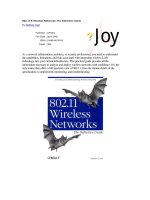OReilly 802 dot 11 wireless networks the definitive guide 2nd edition apr 2005 ISBN 0596100523
Bạn đang xem bản rút gọn của tài liệu. Xem và tải ngay bản đầy đủ của tài liệu tại đây (10.76 MB, 1,192 trang )
802.11®WirelessNetworksTheDefinitiveGuide
ByMatthewGast
...............................................
Publisher:O'Reilly
PubDate:April2005
ISBN:0-596-10052-3
Pages:656
TableofContents|Index
Asweallknowbynow,wirelessnetworksoffermanyadvantagesoverfixed(orwired)
networks.Foremostonthatlistismobility,sincegoingwirelessfreesyoufromthetether
ofanEthernetcableatadesk.Butthat'sjustthetipofthecable-freeiceberg.Wireless
networksarealsomoreflexible,fasterandeasierforyoutouse,andmoreaffordableto
deployandmaintain.
Thedefactostandardforwirelessnetworkingisthe802.11protocol,whichincludesWi-Fi
(thewirelessstandardknownas802.11b)anditsfastercousin,802.11g.Witheasy-toinstall802.11networkhardwareavailableeverywhereyouturn,thechoiceseemssimple,
andmanypeoplediveintowirelesscomputingwithlessthoughtandplanningthanthey'd
givetoawirednetwork.Butit'swisetobefamiliarwithboththecapabilitiesandrisks
associatedwiththe802.11protocols.And802.11WirelessNetworks:TheDefinitiveGuide,
2ndEditionistheperfectplacetostart.
Thisupdatededitioncoverseverythingyou'lleverneedtoknowaboutwirelesstechnology.
Designedwiththesystemadministratororserioushomeuserinmind,it'sano-nonsense
guideforsettingup802.11onWindowsandLinux.Amongthewiderangeoftopics
coveredarediscussionson:
deploymentconsiderations
networkmonitoringandperformancetuning
wirelesssecurityissues
howtouseandselectaccesspoints
networkmonitoringessentials
wirelesscardconfiguration
securityissuesuniquetowirelessnetworks
Withwirelesstechnology,theadvantagestoitsusersareindeedplentiful.Companiesno
longerhavetodealwiththehassleandexpenseofwiringbuildings,andhouseholdswith
severalcomputerscanavoidfightsoverwho'sonline.Andnow,with802.11Wireless
Networks:TheDefinitiveGuide,2ndEdition,youcanintegratewirelesstechnologyinto
yourcurrentinfrastructurewiththeutmostconfidence.
802.11®WirelessNetworksTheDefinitiveGuide
ByMatthewGast
...............................................
Publisher:O'Reilly
PubDate:April2005
ISBN:0-596-10052-3
Pages:656
TableofContents|Index
Copyright
Foreword
Preface
PrometheusUntethered:ThePossibilitiesofWirelessLANs
Audience
OvertureforBookinBlackandWhite,Opus2
ConventionsUsedinThisBook
HowtoContactUs
SafariEnabled
Acknowledgments
Chapter1.IntroductiontoWirelessNetworking
WhyWireless?
WhatMakesWirelessNetworksDifferent
ANetworkbyAnyOtherName...
Chapter2.Overviewof802.11Networks
IEEE802NetworkTechnologyFamilyTree
802.11NomenclatureandDesign
802.11NetworkOperations
MobilitySupport
Chapter3.802.11MACFundamentals
ChallengesfortheMAC
MACAccessModesandTiming
Contention-BasedAccessUsingtheDCF
FragmentationandReassembly
FrameFormat
EncapsulationofHigher-LayerProtocolsWithin802.11
Contention-BasedDataService
FrameProcessingandBridging
Chapter4.802.11FraminginDetail
DataFrames
ControlFrames
ManagementFrames
FrameTransmissionandAssociationandAuthenticationStates
Chapter5.WiredEquivalentPrivacy(WEP)
CryptographicBackgroundtoWEP
WEPCryptographicOperations
ProblemswithWEP
DynamicWEP
Chapter6.UserAuthenticationwith802.1X
TheExtensibleAuthenticationProtocol
EAPMethods
802.1X:NetworkPortAuthentication
802.1XonWirelessLANs
Chapter7.802.11i:RobustSecurityNetworks,TKIP,andCCMP
TheTemporalKeyIntegrityProtocol(TKIP)
CounterModewithCBC-MAC(CCMP)
RobustSecurityNetwork(RSN)Operations
Chapter8.ManagementOperations
ManagementArchitecture
Scanning
Authentication
Preauthentication
Association
PowerConservation
TimerSynchronization
SpectrumManagement
Chapter9.Contention-FreeServicewiththePCF
Contention-FreeAccessUsingthePCF
DetailedPCFFraming
PowerManagementandthePCF
Chapter10.PhysicalLayerOverview
Physical-LayerArchitecture
TheRadioLink
RFPropagationwith802.11
RFEngineeringfor802.11
Chapter11.TheFrequency-Hopping(FH)PHY
Frequency-HoppingTransmission
GaussianFrequencyShiftKeying(GFSK)
FHPHYConvergenceProcedure(PLCP)
Frequency-HoppingPMDSublayer
CharacteristicsoftheFHPHY
Chapter12.TheDirectSequencePHYs:DSSSandHR/DSSS(802.11b)
DirectSequenceTransmission
DifferentialPhaseShiftKeying(DPSK)
The"Original"DirectSequencePHY
ComplementaryCodeKeying
HighRateDirectSequencePHY
Chapter13.802.11aand802.11j:5-GHzOFDMPHY
OrthogonalFrequencyDivisionMultiplexing(OFDM)
OFDMasAppliedby802.11a
OFDMPLCP
OFDMPMD
CharacteristicsoftheOFDMPHY
Chapter14.802.11g:TheExtended-RatePHY(ERP)
802.11gComponents
ERPPhysicalLayerConvergence(PLCP)
ERPPhysicalMediumDependent(PMD)Layer
Chapter15.APeekAheadat802.11n:MIMO-OFDM
CommonFeatures
WWiSE
TGnSync
ComparisonandConclusions
Chapter16.802.11Hardware
GeneralStructureofan802.11Interface
Implementation-SpecificBehavior
ReadingtheSpecificationSheet
Chapter17.Using802.11onWindows
WindowsXP
Windows2000
WindowsComputerAuthentication
Chapter18.802.11ontheMacintosh
TheAirPortExtremeCard
802.1XontheAirPort
Chapter19.Using802.11onLinux
PCMCIASupportonLinux
LinuxWirelessExtensionsandTools
Agere(Lucent)Orinoco
Atheros-BasedcardsandMADwifi
802.1XonLinuxwithxsupplicant
Chapter20.Using802.11AccessPoints
GeneralFunctionsofanAccessPoint
PoweroverEthernet(PoE)
SelectingAccessPoints
Cisco1200AccessPoint
AppleAirPort
Chapter21.LogicalWirelessNetworkArchitecture
EvaluatingaLogicalArchitecture
TopologyExamples
ChoosingYourLogicalArchitecture
Chapter22.SecurityArchitecture
SecurityDefinitionandAnalysis
AuthenticationandAccessControl
EnsuringSecrecyThroughEncryption
SelectingSecurityProtocols
RogueAccessPoints
Chapter23.SitePlanningandProjectManagement
ProjectPlanningandRequirements
NetworkRequirements
PhysicalLayerSelectionandDesign
PlanningAccess-PointPlacement
UsingAntennastoTailorCoverage
Chapter24.802.11NetworkAnalysis
NetworkAnalyzers
Ethereal
802.11NetworkAnalysisChecklist
OtherTools
Chapter25.802.11PerformanceTuning
802.11PerformanceCalculations
ImprovingPerformance
Tunable802.11Parameters
Chapter26.ConclusionsandPredictions
StandardsWork
CurrentTrendsinWirelessNetworking
TheEnd
glossary
AbouttheAuthor
Colophon
Index
802.11®WirelessNetworks:TheDefinitiveGuide,
SecondEdition
byMatthewS.Gast
Copyright©2005MatthewS.Gast.Allrightsreserved.
PrintedintheUnitedStatesofAmerica.
PublishedbyO'ReillyMedia,Inc.,1005GravensteinHighway
North,Sebastopol,CA95472.
O'Reillybooksmaybepurchasedforeducational,business,or
salespromotionaluse.Onlineeditionsarealsoavailablefor
mosttitles(safari.oreilly.com).Formoreinformation,contact
ourcorporate/institutionalsalesdepartment:(800)998-9938or
Editor:
MikeLoukides
ProductionEditor:
ColleenGorman
CoverDesigner:
EllieVolckhausen
InteriorDesigner:
DavidFutato
PrintingHistory:
April2002:
FirstEdition.
April2005:
SecondEdition.
NutshellHandbook,theNutshellHandbooklogo,andthe
O'ReillylogoareregisteredtrademarksofO'ReillyMedia,Inc.
802.11®WirelessNetworks:TheDefinitiveGuide,Second
Edition,theimageofahorseshoebat,andrelatedtradedress
aretrademarksofO'ReillyMedia,Inc.
802.11®andall802.11-basedtrademarksandlogosare
trademarksorregisteredtrademarksofIEEE,Inc.intheUnited
Statesandothercountries.O'ReillyMedia,Inc.isindependent
ofIEEE.
Manyofthedesignationsusedbymanufacturersandsellersto
distinguishtheirproductsareclaimedastrademarks.Where
thosedesignationsappearinthisbook,andO'ReillyMedia,Inc.
wasawareofatrademarkclaim,thedesignationshavebeen
printedincapsorinitialcaps.
Whileeveryprecautionhasbeentakeninthepreparationofthis
book,thepublisherandauthorassumenoresponsibilityfor
errorsoromissions,orfordamagesresultingfromtheuseof
theinformationcontainedherein.
ISBN:0-596-10052-3
[M]
Foreword
MatthewGastwasmymentorlongbeforeImethim.Ibegan
reportingonwirelessdatanetworkinginOctober2000whenI
discoveredthatApple'sclaimsforits802.11b-basedAirPort
BaseStationwereactuallytrue.
I'dbeenburnedwithanotherformofwirelessnetworkingthat
usedinfrared,andhadspentmanyfruitlesshoursusingother
"interesting"networkingtechnologiesthatledtodeadends.I
figured802.11bwasjustanotherone.WasIgladIwaswrong!
Thisdiscoverytookmedownapaththatled,inexorably,tothe
firsteditionof802.11WirelessNetworks.Howdidthisstuff
actuallyworkasadvertised?IknewplentyabouttheISO
model,TCP/IP,andEthernetframes,butIcouldn'treconcilea
mediuminwhichallpartiestalkedinthesamespacewithwhat
IknewaboutEthernet'smethodsofcopingwithshared
contention.
MatthewtaughtmethroughwordsandfiguresthatIdidn't
originallyunderstand,butreturnedtoagainandagainasI
descendedfurtherintotechnicaldetailinmyattemptsto
explainWi-Fitoabroaderandbroaderaudiencethrough
articlesinTheNewYorkTimes,TheSeattleTimes,PCWorld,
andmyownWi-FiNetworkingNews
()siteoverthelastfiveyears.
Istartinglearningacronymsfrom802.11WirelessNetworks
andusedMatthew'sbooktogobeyondexpandingWDSinto
WirelessDistributionSystemintounderstandingpreciselyhow
twoaccesspointscouldexchangedatawitheachotherthrough
abuilt-in802.11mechanismthatallowedfourpartiestoa
packet'stransit.
Nowastimewentbyandthe802.11familygrewandbecame
baroque,thefirsteditionofthistitlestartedfeelingalittleout
ofdatealthoughitremainedsurprisinghowmany"new"
innovationswerefirmlyrootedindevelopmentsoftheearlyto
mid-1990s.Thealphabetsoupofthefirsteditionwasgruel
comparedtothemulligatawnyof2005.
Matthewfilledthegapbetweenthebookandcontemporary
wirelessrealitythroughhisongoingwritingatO'Reilly's
WirelessDevCenter,whichIreadavidly.Andsomewherein
thereIwasintroducedtoMatthewataWi-FiPlanetconference.
Wehititoffimmediately:Istartedpesteringhimfordetails
about802.1X,ifIremembercorrectly,andhewantedtotalk
aboutbooksandbusiness.(Iwoundupwritingtwoeditionsofa
generalmarketWi-Fibook,neitherofwhichdidnearlyaswell
asMatthew'sextraordinarilytechnicalone.)
Sincethen,Ihavebeenintherareandprivilegedpositiontobe
therecipientofMatthew'sgenerositywithhisknowledgeand
humbleinsight.Matthewisn'tonewhoassumes;heresearches.
Hisnaturalcuriositycompelshimtodiguntilhegetsananswer
that'stechnicallyandlogicallyconsistent.
Take,forinstance,theincrediblypoliticalandcomplicated
evolutionofthe802.1Xstandard.(Iknow,fromMatthew,that
it'sproperlycapitalizedsinceit'safreestandingstandardnot
reliantonotherspecifications.EventheIEEEmakesthis
mistake,andit'stheirruleforcapitalizationthatwe'reboth
following.)
802.1XissimpleenoughinitsuseoftheExtensible
AuthenticationProtocol,agenericmethodofpassingmessages
amongpartiestoauthentication.ButthewaysinwhichEAPis
securedare,quitefrankly,insanereflectingMicrosoftandCisco's
parallelbutconflictingattemptstocontrolsupportoflegacy
protocolsinawaythatonlydamageseasyaccesstoitshigher
levelofsecurity.
Mattheweschewedthereligiousdebateandspelledoutthe
variousmethods,difficulties,andinteroperabilityissuesinan
O'ReillyNetworkarticlethat'sthenuggetoftheexpanded
coverageinthisbook.Idefyanyreadertofindascogentand
exhaustiveanexplanationbeforethisbookwaspublished.
There'snothingasclear,comprehensive,andunaffectedby
marketpolitics.
Attimes,Matthewbemoanedthedelaysthatledtothegap
betweeneditionsofthisbook,duepartlytohisjoiningastartup
wirelessLANswitchcompany,butIthinkreadersarebetter
servedthroughhisveryhard-won,late-night,long-hours
knowledge.
Matthew'srelationshipwith802.11mighthavepreviouslybeen
consideredthatofahandymanwhoknewhiswayaroundthe
infrastructureofhishouse.Ifatoiletwasrunning,hecould
replaceavalve.Ifthelivingroomneedednewoutlets,hecould
researchtheprocessandwirethemin.
ButMatthew'snewjobtookhimallegoricallyfromaweekend
householdwarriortoajack-of-all-tradesman.Matthewcantear
outthoseinnerwalls,reframe,plumb,andwirethem,allthe
whilebitchingaboutthelocalbuildingcode.
It'sbeenapleasureknowingMatthew,andit'sevenmorea
pleasuretointroduceyoutohisbook,andletyouallinonwhat
Iandothershavebeenmoreprivaterecipientsofforthelast
fewyears.
GlennFleishman
Seattle,Washington
February2005
Preface
Peoplemove.Networksdon't.
Morethananythingelse,thesetwostatementscanexplainthe
explosionofwirelessLANhardware.Injustafewyears,
wirelessLANshavegrownfromahigh-priced,alpha-geek
curiositytomainstreamtechnology.
Byremovingthenetworkportfromtheequation,wireless
networksseparateuserconnectivityfromadirectphysical
locationattheendofacord.Toabstracttheuserlocationfrom
thenetwork,however,requiresagreatdealofprotocol
engineering.Foruserstohavelocation-independentservices,
thenetworkmustbecomemuchmoreawareoftheirlocation.
Thisbookhasbeenwrittenonmoreairplanes,inmoreairports,
andonmoretrainsthanIcaretocount.Muchoftheresearch
involvedindistillingevolvingnetworktechnologyintoabook
dependsonInternetaccess.Itissafetosaythatwithout
ubiquitousnetworkaccess,thearrivalofthisbookwouldhave
beenmuchdelayed.
Theadvantagesofwirelessnetworkshasmadethemafastgrowingmultibilliondollarequipmentmarket.WirelessLANsare
nowafixtureonthenetworkinglandscape,whichmeansyou
needtolearntodealwiththem.
PrometheusUntethered:ThePossibilitiesof
WirelessLANs
Wirelessnetworksofferseveraladvantagesoverfixed(or
"wired")networks:
Mobility
Usersmove,butdataisusuallystoredcentrally,enabling
userstoaccessdatawhiletheyareinmotioncanleadto
largeproductivitygains.Networksarebuiltbecausethey
offervaluableservicestousers.Inthepast,network
designershavefocusedonworkingwithnetworkports
becausethatiswhattypicallymapstoauser.Withwireless,
therearenoports,andthenetworkcanbedesignedaround
useridentity.
Easeandspeedofdeployment
ManyareasaredifficulttowirefortraditionalwiredLANs.
Olderbuildingsareoftenaproblem;runningcablethrough
thewallsofanolderstonebuildingtowhichtheblueprints
havebeenlostcanbeachallenge.Inmanyplaces,historic
preservationlawsmakeitdifficulttocarryoutnewLAN
installationsinolderbuildings.Eveninmodernfacilities,
contractingforcableinstallationcanbeexpensiveandtimeconsuming.
Flexibility
Nocablesmeansnorecabling.Wirelessnetworksallow
userstoquicklyformamorphous,smallgroupnetworksfor
ameeting,andwirelessnetworkingmakesmovingbetween
cubiclesandofficesasnap.Expansionwithwireless
networksiseasybecausethenetworkmediumisalready
everywhere.Therearenocablestopull,connect,ortrip
over.Flexibilityisthebigsellingpointforthe"hotspot"
market,composedmainlyofhotels,airports,trainstations
(andeventrainsthemselves!),libraries,andcafes.
Cost
Insomecases,costscanbereducedbyusingwireless
technology.Asanexample,802.11®equipmentcanbe
usedtocreateawirelessbridgebetweentwobuildings.
Settingupawirelessbridgerequiressomeinitialcapital
costintermsofoutdoorequipment,accesspoints,and
wirelessinterfaces.Aftertheinitialcapitalexpenditure,
however,an802.11-based,line-of-sightnetworkwillhave
onlyanegligiblerecurringmonthlyoperatingcost.Over
time,point-to-pointwirelesslinksarefarcheaperthan
leasingcapacityfromthetelephonecompany.
Untilthecompletionofthe802.11standardin1997,however,
userswantingtotakeadvantageoftheseattributeswereforced
toadoptsingle-vendorsolutionswithalloftheriskthat
entailed.Once802.11startedtheballrolling,speedsquickly
increasedfrom2Mbpsto11Mbpsto54Mbps.Standardized
wirelessinterfacesandantennashavemadeitmucheasierto
buildwirelessnetworks.Severalserviceprovidershavejumped
attheidea,andenthusiasticbandsofvolunteersinmostmajor
citieshavestartedtobuildpublicwirelessnetworksbasedon
802.11.
802.11hasbecomesomethingofauniversallyassumed
connectivitymethodaswell.Ratherthanwiringpublicaccess
portsupwithEthernet,acollectionofaccesspointscanprovide
connectivitytoguests.Intheyearssince802.11was
standardized,so-called"hotspots"havegonefromanexotic
curiosityinvenuesthatdonotmove,totechnologythatis
providingconnectivityevenwhileintransit.Bycoupling802.11
accesswithasatelliteuplink,itispossibletoprovideInternet
accessevenwhilemovingquickly.Severalcommuterrail
systemsprovidemobilehot-spots,andBoeing'sConnexion
servicecandothesameforanairplane,evenatacruising
speedof550milesperhour.
Audience
Thisbookisintendedforreaderswhoneedtolearnmoreabout
thetechnicalaspectsofwirelessLANs,fromoperationsto
deploymenttomonitoring:
Networkarchitectscontemplatingrollingout802.11
equipmentontonetworksorbuildingnetworksbasedon
802.11
Networkadministratorsresponsibleforbuildingand
maintaining802.11networks
Securityprofessionalsconcernedabouttheexposurefrom
deploymentof802.11equipmentandinterestedin
measurestoreducethesecurityheadaches
Thebookassumesthatyouhaveasolidbackgroundin
computernetworks.Youshouldhaveabasicunderstandingof
IEEE802networks(particularlyEthernet),theOSIreference
model,andtheTCP/IPprotocols,inadditiontoanyother
protocolsonyournetwork.WirelessLANsarenottotallynew
groundformostnetworkadministrators,buttherewillbenew
concepts,particularlyinvolvingradiotransmissions.
OvertureforBookinBlackandWhite,Opus2
Partofthedifficultyinwritingabookonatechnologythatis
evolvingquicklyisthatyouareneverquitesurewhatto
include.Theyearsbetweenthefirstandsecondeditionwere
filledwithmanydevelopmentsinsecurity,andupdatingthe
security-relatedinformationwasoneofthemajorpartsofthis
revision.Thisbookhastwomainpurposes:itismeanttoteach
thereaderaboutthe802.11standarditself,anditoffers
practicaladviceonbuildingwirelessLANswith802.11
equipment.Thesetwopurposesaremeanttobeindependentof
eachothersoyoucaneasilyfindwhatinterestsyou.Tohelp
youdecidewhattoreadfirstandtogiveyouabetterideaof
thelayout,thefollowingarebriefsummariesofallthechapters.
Chapter1,IntroductiontoWirelessNetworking,listswaysin
whichwirelessnetworksaredifferentfromtraditionalwired
networksanddiscussesthechallengesfacedwhenadaptingto
fuzzyboundariesandunreliablemedia.WirelessLANsare
perhapsthemostinterestingillustrationofChristianHuitema's
assertionthattheInternethasnocenter,justaneverexpandingedge.WithwirelessLANtechnologybecoming
commonplace,thatedgeisnowblurring.
Chapter2,Overviewof802.11Networks,describestheoverall
architectureof802.11wirelessLANs.802.11issomewhatlike
Ethernetbutwithanumberofnewnetworkcomponentsanda
lotofnewacronyms.Thischapterintroducesyoutothe
networkcomponentsthatyou'llworkwith.Broadlyspeaking,
thesecomponentsarestations(mobiledeviceswithwireless
cards),accesspoints(glorifiedbridgesbetweenthestations
andthedistributionsystem),andthedistributionsystemitself
(thewiredbackbonenetwork).Stationsaregroupedlogically
intoBasicServiceSets(BSSs).Whennoaccesspointis
present,thenetworkisaloose,ad-hocconfederationcalledan
independentBSS(IBSS).Accesspointsallowmorestructureby
connectingdisparatephysicalBSSsintoafurtherlogical
groupingcalledanExtendedServiceSet(ESS).
Chapter3,802.11MACFundamentals,describestheMedia
AccessControl(MAC)layerofthe802.11standardindetail.
802.11,likeallIEEE802networks,splitstheMAC-layer
functionalityfromthephysicalmediumaccess.Severalphysical
layersexistfor802.11,buttheMACisthesameacrossallof
them.Themainmodeforaccessingthenetworkmediumisa
traditionalcontention-basedaccessmethod,thoughitemploys
collisionavoidance(CSMA/CA)ratherthancollisiondetection
(CSMA/CD).Thechapteralsodiscussesdataencapsulationin
802.11framesandhelpsnetworkadministratorsunderstand
theframesequencesusedtotransferdata.
Chapter4,802.11FraminginDetail,buildsontheendof
Chapter3bydescribingthevariousframetypesandwherethey
areused.Thischapterisintendedmoreasareferencethan
actualreadingmaterial.Itdescribesthethreemajorframe
classes.Dataframesaretheworkhorseof802.11.Control
framesservesupervisorypurposes.Managementframesassist
inperformingtheextendedoperationsofthe802.11MAC.
Beaconsannouncetheexistenceofan802.11network,assistin
theassociationprocess,andareusedforauthenticating
stations.
Chapter5,WiredEquivalentPrivacy(WEP),describestheWired
EquivalentPrivacyprotocol.Inspiteofitsflaws,WEPisthe
basisformuchofthefollowingworkinwirelessLANsecurity.
ThischapterdiscusseswhatWEPis,howitworks,andwhyyou
can'trelyonitforanymeaningfulprivacyorsecurity.
Chapter6,UserAuthenticationwith802.1X,describesthe
802.1Xauthenticationframework.Inconjunctionwiththe
ExtensibleAuthenticationProtocol,802.1Xprovidesstrong
authenticationsolutionsandimprovedencryptiononWireless
LANs.
Chapter7,802.11i:RobustSecurityNetworks,TKIP,andCCMP,
describesthe802.11istandardforwirelessLANsecurity.In
recognitionofthefundamentalflawsofWEP,twonewlink-layer
encryptionprotocolsweredesigned,completewithnew
mechanismstoderiveanddistributekeys.
Chapter8,ManagementOperations,describesthemanagement
operationson802.11networks.Tofindnetworkstojoin,
stationsscanforactivenetworksannouncedbyaccesspointsor
theIBSScreator.Beforesendingdata,stationsmustassociate
withanaccesspoint.ThischapteralsodiscussesthepowermanagementfeaturesincorporatedintotheMACthatallow
battery-poweredstationstosleepandpickupbufferedtrafficat
periodicintervals.
Chapter9,Contention-FreeServicewiththePCF,describesthe
pointcoordinationfunction.ThePCFisnotwidelyimplemented,
sothischaptercanbeskippedformostpurposes.ThePCFis
thebasisforcontention-freeaccesstothewirelessmedium.
Contention-freeaccessislikeacentrallycontrolled,tokenbasedmedium,whereaccesspointsprovidethe"token"
function.
Chapter10,PhysicalLayerOverview,describesthegeneral
architectureofthephysicallayer(PHY)inthe802.11model.
ThePHYitselfisbrokendownintotwo"sublayers."ThePhysical
LayerConvergenceProcedure(PLCP)addsapreambletoform
thecompleteframeanditsownheader,whilethePhysical
MediumDependent(PMD)sublayerincludesmodulationdetails.
ThemostcommonPHYsuseradiofrequency(RF)asthe
wirelessmedium,sothechaptercloseswithashortdiscussion
onRFsystemsandtechnologythatcanbeappliedtoanyPHY
discussedinthebook.
Chapter11,TheFrequency-Hopping(FH)PHY,describesthe
oldestphysicallayerwith802.11.ProductsbasedontheFHPHY
arenolongerwidelysold,butagreatdealofearly802.11
equipmentwasbasedonthem.Organizationswithalong
historyofinvolvementwith802.11technologymayneedtobe
familiarwiththisPHY.
Chapter12,TheDirectSequencePHYs:DSSSandHR/DSSS
(802.11b),describestwophysicallayersbasedondirect
sequencespreadspectrumtechnology.Theinitial802.11
standardincludedalayerwhichofferedspeedsof1Mbpsand2
Mbps.Whileinteresting,itwasnotuntil802.11badded5.5
Mbpsand11Mbpsdataratesthatthetechnologyreallytook
off.Thischapterdescribesthetwoclosely-relatedPHYsasa
singlepackage.
Chapter13,802.11aand802.11j:5-GHzOFDMPHY,describes
the5-GHzPHYstandardizedwith802.11a,whichoperatesat54
Mbps.Thisphysicallayerusesanothermodulationtechnique
knownasorthogonalfrequencydivisionmultiplexing(OFDM).
SlightmodificationswererequiredtousethisPHYinJapan,
whichweremadebythe802.11jstandard.
Chapter14,802.11g:TheExtended-RatePHY(ERP),describes
aPHYwhichusesOFDMtechnology,butinthe2.4GHz
frequencybandsharedby802.11b.Ithaslargelysupplanted
802.11b,andisacommonoptionforbuilt-inconnectivitywith
newnotebookcomputers.ThePHYitselfisalmostidenticalto
the802.11aPHY.Thedifferencesareinallowingforbackwards
compatibilitywitholderequipmentsharingthesamefrequency
band.
Chapter15,APeekAheadat802.11n:MIMO-OFDM,describes
thePHYcurrentlyindevelopment.802.11nusesaPHYbased
onmultiple-input/multiple-output(MIMO)technologyformuch
higherspeed.Atthetimethisbookwenttopress,twoproposed
standardswereduelinginthecommittee.Thischapter
describesboth.
Chapter16,802.11Hardware,beginsthetransitionfrom
theoreticalmattersbasedonthestandardstohowthe
standardsareimplemented.802.11isarelativelyloose
standard,andallowsalargenumberofimplementationchoices.
Cardsmaydifferintheirspecifiedperformance,orinthe
mannerinwhichcertainprotocolsareimplemented.Manyof
thesevariationsarebasedonhowtheyarebuilt.
Chapter17,Using802.11onWindows,describesthebasic
driverinstallationprocedureinWindows,andhowtoconfigure
securitysettings.
Chapter18,802.11ontheMacintosh,describeshowtousethe
AirPortcardonMacOSXtoconnectto802.11networks.It
focusesonMacOSX10.3,whichwasthefirstsoftwareversion
toinclude802.1Xsupport.
Chapter19,Using802.11onLinux,discusseshowtoinstall
802.11supportonaLinuxsystem.Afterdiscussinghowtoadd
PCCardsupporttotheoperatingsystem,itshowshowtouse
thewirelessextensionsAPI.Itdiscussestwocommondrivers,
onefortheolderOrinoco802.11bcard,andtheMADwifidriver
fornewercardsbasedonchipsetsfromAtheros
Communications.Finally,itshowshowtoconfigure802.1X
securityusingxsupplicant.
Chapter20,Using802.11AccessPoints,describesthe
equipmentusedontheinfrastructureendof802.11networks.
Commercialaccesspointproductshavevaryingfeatures.This
chapterdescribesthecommonfeaturesofaccesspoints,offers
buyingadvice,andpresentstwopracticalconfiguration
examples.
Chapter21,LogicalWirelessNetworkArchitecture,marksthe
thirdtransitioninthebook,fromtheimplementationof802.11
onthescaleofanindividualdevice,tohowtobuild802.11
networksonalargerscale.Thereareseveralmajorstylesthat
canbeusedtobuildthenetwork,eachwithitsadvantagesand
disadvantages.Thischaptersortsthroughthecommontypesof
networktopologiesandoffersadviceonselectingone.
Chapter22,SecurityArchitecture,shouldbereadintandem
withthepreviouschapter.Maintainingnetworksecuritywhile
offeringnetworkaccessonanopenmediumisamajor
challenge.Securitychoicesandarchitecturechoicesare
mutuallyinfluential.Thischapteraddressesthemajorchoices
tobemadeindesigninganetwork:whattypeofauthentication
willbeusedandhowitintegrateswithexistinguserdatabases,
howtoencrypttraffictokeepitsafe,andhowtodealwith
unauthorizedaccesspointdeployment.
Chapter23,SitePlanningandProjectManagement,isthefinal
componentofthebookfornetworkadministrators.Designinga
large-scalewirelessnetworkisdifficultbecausethereisgreat
userdemandforaccess.Ensuringthatthenetworkhas
sufficientcapacitytosatisfyuserdemandsinallthelocations
whereitwillbeusedrequiressomeplanning.Choosing
locationsforaccesspointsdependsagreatdealontheradio
environment,andhastraditionallybeenoneofthemosttimeconsumingtasksinbuildinganetwork.
Chapter24,802.11NetworkAnalysis,teachesadministrators
howtorecognizewhat'sgoingonwiththeirwirelessLANs.
Networkanalyzershaveproventheirworthtimeandtimeagain
onwirednetworks.Wirelessnetworkanalyzersarejustas
valuableatoolfor802.11networks.Thischapterdiscusseshow
tousewirelessnetworkanalyzersandwhatcertainsymptoms
mayindicate.Italsodescribeshowtobuildananalyzerusing
Ethereal,andwhattolookfortotroubleshootcommon
problems.
Chapter25,802.11PerformanceTuning,describeshow
networkadministratorscanincreasethroughput.Itbeginsby
describinghowtocalculateoverallthroughputforpayloaddata,
andcommonwaysofincreasingperformance.Inrarecases,it
maymakesensetochangecommonlyexposed802.11
parameters.
Chapter26,ConclusionsandPredictions,summarizescurrent
standardsworkinthe802.11workinggroup.Aftersummarizing
theworkinprogress,IgettoprognosticateandhopethatI
don'thavetorevisethistooextensivelyinfutureeditions.
MajorChangesfromtheFirstEdition
Thethreeyearsbetween2002and2005sawagreatdealof
changeinwirelessLANs.Thestandardsthemselvescontinued
toevolvetoprovidegreatersecurityandinteroperability.
Followingthetypicaltechnologypathof"faster,better,and
cheaper,"thedatarateofmost802.11interfaceshasshotfrom
2or11Mbpswith802.11bto54Mbpswith802.11aand
802.11g.Increasedspeedwithbackwardscompatibilityhas
provedtobeacommerciallysuccessfulformulafor802.11g,
evenifithaslimitationswhenusedforlarge-scalenetworks.
Thecomingstandardizationof802.11nissettoboostspeeds
evenfarther.NewdevelopmentsinPHYtechnologyare
anxiouslyawaitedbyusers,asshownbythepopularreleasesof
pre-standardtechnology.Twoentirelynewchaptersaredevoted
to802.11gand802.11n.Europeanadoptionof802.11awas
contingentonthedevelopmentofspectrummanagementin
802.11h,whichresultedinextensiverevisionstothe
managementchapter.
Whenthefirsteditionwasreleasedin2002,theperceptionof
insecuritydominateddiscussionsofthetechnology.WEPwas
clearlyinsufficient,buttherewasnogoodalternative.Most
networkadministratorsweremakingdowithremoteaccess
systemsturnedinward,ratherthantheirnaturaloutward
orientation.Thedevelopmentof802.11iwasdoneagreatdeal
tosimplifynetworksecurity.Securityisnowbuiltintothe
specification,ratherthansomethingwhichmustbeaddedon
aftergettingthenetworkright.Securityimprovements
permeatethebook,fromnewchaptersshowinghowthenew
protocolswork,toshowinghowtheycanbeusedontheclient
side,tohowtosortthroughdifferentoptionswhenbuildinga
network.Sortingthroughsecurityoptionsismuchmore
complexnowthanitwasthreeyearsago,andmadeit
necessarytoexpandasectionofthedeploymentdiscussionin
thefirsteditionintoitsownchapter.
Threeyearsago,mostaccesspointswereexpensivedevices
thatdidnotworkwellinlargenumbers.Networkdeployment
wasoftenanexerciseinworkingaroundthelimitationsofthe
devicesofthetime.Threeyearslater,vastlymorecapable
devicesallowmuchmoreflexibledeploymentmodels.Rather
thanjusta"onesizefitsall"deploymentmodel,therearenow
multipleoptionstosortthrough.Securityprotocolshave
improvedenoughthatdiscussionsofdeployingtechnologyare
basedonwhatitcandofortheorganization,notonfearand
howtokeepitcontrolled.Asaresult,theoriginalchapteron
networkdeploymenthasgrownintothree,eachtacklinga
majorpartofthedeploymentprocess.









